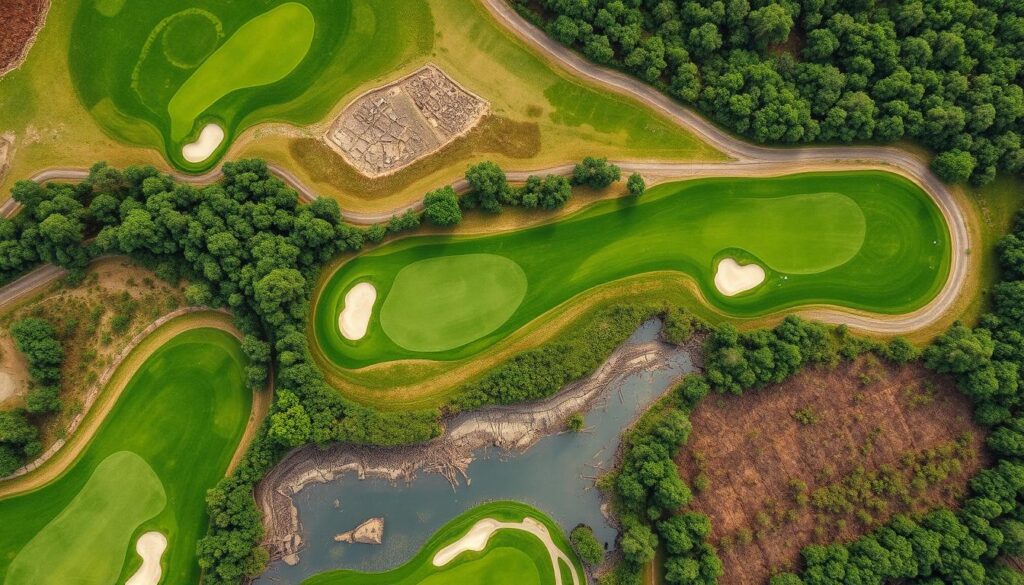The median cost to construct an 18-hole golf course stands at a staggering $14 million. This figure does not include the cost of acquiring the land. The total expense for such projects can vary widely, from $7 million to $25 million, depending on several factors.
Many elements influence the construction costs of a golf course. For example, the cost of building greens can reach up to $60 per square foot. Given that an average 18-hole course spans 140 to 180 acres, it’s clear how expenses can escalate quickly.
Creating a budget for a golf course entails considering various components. Clearing and grubbing the land can exceed $250,000, while replacing topsoil might cost around $300,000. Drainage systems are another significant expense, costing approximately $750,000. Irrigation systems, on the other hand, can range from $150,000 to over $1 million.
The type of course being built also affects the overall cost. A 9-hole par-3 course can be constructed on as little as 65 acres, potentially reducing expenses. However, an elite 18-hole course may require premium features like cart paths, which can cost up to $500,000, and water features, which may run about $200,000.
It is essential to understanding these costs for anyone considering golf course development. Whether planning a public course or a private club, understanding the budget can aid in making informed decisions and crafting a viable financial plan.
Key Takeaways
- The median cost to build an 18-hole golf course is $14 million
- Golf course construction costs range from $7 million to $25 million
- Building greens can cost up to $60 per square foot
- An average 18-hole course requires 140 to 180 acres of land
- Irrigation systems can cost between $150,000 and $1 million
- The entire construction process typically takes 1 to 2 years
Table of Contents
- 1 Introduction
- 2 Factors Influencing the Cost of Building a Golf Course
- 3 Land Acquisition
- 4 Course Design and Planning
- 5 Construction Costs
- 6 Infrastructure and Facilities
- 7 Landscaping and Aesthetics
- 8 Types of Golf Courses and Their Costs
- 9 Public vs. Private Golf Courses
- 10 9-Hole vs. 18-Hole Courses
- 11 Specialty Courses (e.g., Par 3, Executive)
- 12 Financing and Budgeting for a Golf Course
- 13 Funding Sources
- 14 Budget Management
- 15 Case Studies: Examples of Golf Course Construction Costs
- 16 Environmental and Regulatory Considerations
Introduction
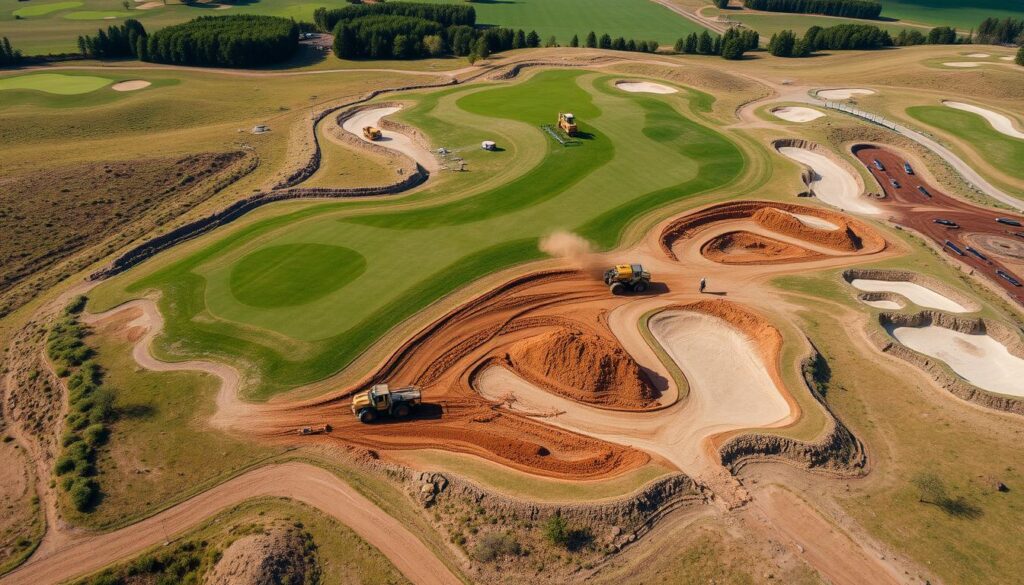
The golf course construction industry is intricate and ever-evolving. It’s not just about reshaping land and seeding it with grass. This process demands meticulous planning, significant investment, and specialized knowledge. For developers, investors, or golf enthusiasts, understanding the financial aspects is essential.
Overview of the Golf Course Construction Industry
The evolution of the golf course construction industry has been remarkable. Today, it encompasses architects, engineers, and environmental specialists. These professionals collaborate to design courses that are both challenging and eco-friendly. For instance, Fort Worth, Texas, is home to several top-rated public golf courses, illustrating the industry’s prowess.
Understanding Golf Course Development Costs
Development costs for golf courses vary significantly. Factors like location, design intricacy, and amenities play a role. Below is a detailed breakdown of typical expenses:
| Expense Category | Average Cost Range (USD) |
|---|---|
| Land Acquisition and Development | $2,000,000 – $10,000,000 |
| Course Design and Construction | $3,000,000 – $15,000,000 |
| Clubhouse and Pro Shop | $500,000 – $5,000,000 |
| Maintenance Equipment | $250,000 – $1,000,000 |
| Irrigation System | $500,000 – $2,000,000 |
What to Expect from This Guide
This guide will offer a thorough look at the costs associated with building a golf course. We’ll cover planning, construction, and maintenance expenses. You’ll learn about land acquisition, design, construction costs, and regulatory compliance.
By the conclusion of this guide, you’ll understand the financial implications of creating a golf course. Whether aiming for an 18-hole championship layout or a smaller specialty course, this information is crucial for navigating the golf course construction industry.
Factors Influencing the Cost of Building a Golf Course

Constructing a golf course is a multifaceted endeavor, with numerous factors influencing its cost. Prices can range from $3 million to $30 million or more for an 18-hole layout. This section looks at the primary elements that shape course design expenses and construction variables.
The type of land is a critical determinant of costs. Each type, such as parkland, links, desert, and mountain courses, presents distinct challenges and expenses. The design’s complexity also significantly impacts the budget. Intricate layouts with numerous hazards and landscaping features tend to increase costs.
Economic conditions and industry trends play a role in pricing. Favorable market conditions, like low interest rates, offer opportunities for developers to secure advantageous loans. Competitive bidding from architects and construction firms can also affect expenses.
| Cost Category | Minimalist Course | Average Course | Upscale Course |
|---|---|---|---|
| Mobilization | $10,000 | $40,000 | $75,000 |
| Topsoil Stripping | $40,000 | $150,000 | $300,000 |
| Green Construction (11,150 sq.m) | $36,000 | $300,000 | $600,000 |
| Irrigation and Pump Station | $130,000 | $520,000 | $910,000 |
| Total Building Costs | $521,000 | $2,218,000 | $5,814,000 |
The choice of course type – public, private, or resort – influences both the initial investment and long-term profitability. Private clubs tend to generate higher revenues through membership fees. Resort courses, on the other hand, benefit from additional income streams like lodging and amenities.
Environmental considerations are crucial. Water consumption, habitat preservation, and sustainability measures all impact the cost. Balancing these elements with design goals is essential for creating a successful and environmentally responsible golf course.
Land Acquisition

Golf course land acquisition is a pivotal step in realizing your dream course. The cost for such properties spans from $2 million to a staggering $269 million. The location significantly influences the final cost.
Cost of Purchasing Land
Acreage in the U.S. averages about $12,000. For an 18-hole course, you’ll need 150-200 acres. Prime locations in sought-after areas command higher prices. In 2020, the Gold Canyon Golf Resort sold for $30 million, while The Links at Brick Landing in North Carolina went for just $1.2 million.
Location Considerations
The location you choose impacts more than just the initial cost. It affects construction expenses, potential revenue, and long-term success. Urban areas often have higher land prices but may attract more players. Conversely, rural locations might offer lower prices but could require more infrastructure investment.
Zoning and Environmental Regulations
Zoning for golf courses can be complex. You’ll need to navigate local laws and obtain proper permits. Environmental regulations also play a crucial role. These factors can significantly influence your project’s timeline and budget. It’s wise to consult experts who understand the intricacies of golf course development to ensure compliance and avoid costly delays.
| Cost Factor | Estimated Range |
|---|---|
| Land Acquisition | $2 million – $269 million |
| Average Land Cost per Acre | $12,000 |
| Total Project Costs | $17.2 million (case study) |
| Planning, Design & Approvals | $600,000 (case study) |
Remember, careful planning and thorough research are critical to successful golf course land acquisition. By understanding these factors, you’ll be better equipped to make informed decisions and create a golf course that stands the test of time.
Course Design and Planning
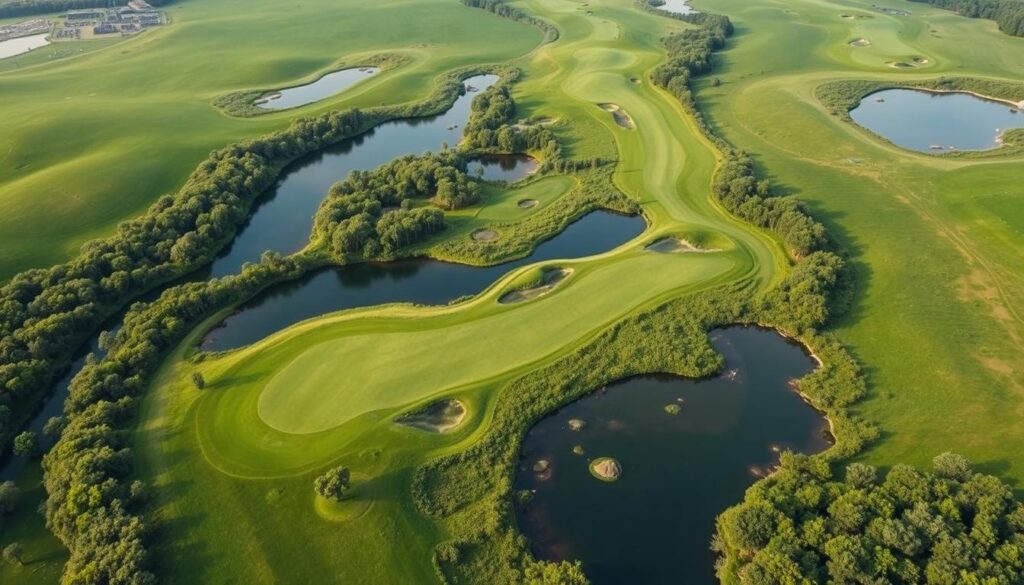
Creating a stunning golf course begins with expert design and meticulous planning. Golf course architect fees are a significant part of your budget. Top designers, though costly, bring unparalleled expertise that elevates the course. The costs vary widely, influenced by the project’s scale and intricacy.
Hiring a Golf Course Architect
Engaging a golf course architect can range from $50,000 to $500,000. This fee is contingent upon the architect’s stature and the project’s magnitude. Renowned architects may command higher fees but their designs often draw more golfers, enhancing your course’s appeal.
Design Complexity and Cost Impact
The intricacy of your course’s design directly correlates with construction expenses. Elements such as extensive bunkering or water hazards escalate costs. A basic layout might be priced around $500,000, whereas a sophisticated course could exceed $6 million.
Environmental and Sustainability Considerations
Sustainable golf course design is increasingly favored. It influences both initial expenditures and ongoing maintenance. Adopting green practices, like native plant species and efficient irrigation, may elevate upfront costs but can yield long-term savings. Certain golf course design tools facilitate the incorporation of these eco-friendly elements.
| Design Element | Estimated Cost Range |
|---|---|
| Land Acquisition (per acre) | $12,000 – $50,000 |
| Golf Course Architect Fees | $50,000 – $500,000 |
| Irrigation System | $250,000 – $1,000,000 |
| Turf and Planting (per sq ft) | $0.50 – $1.50 |
Construction Costs
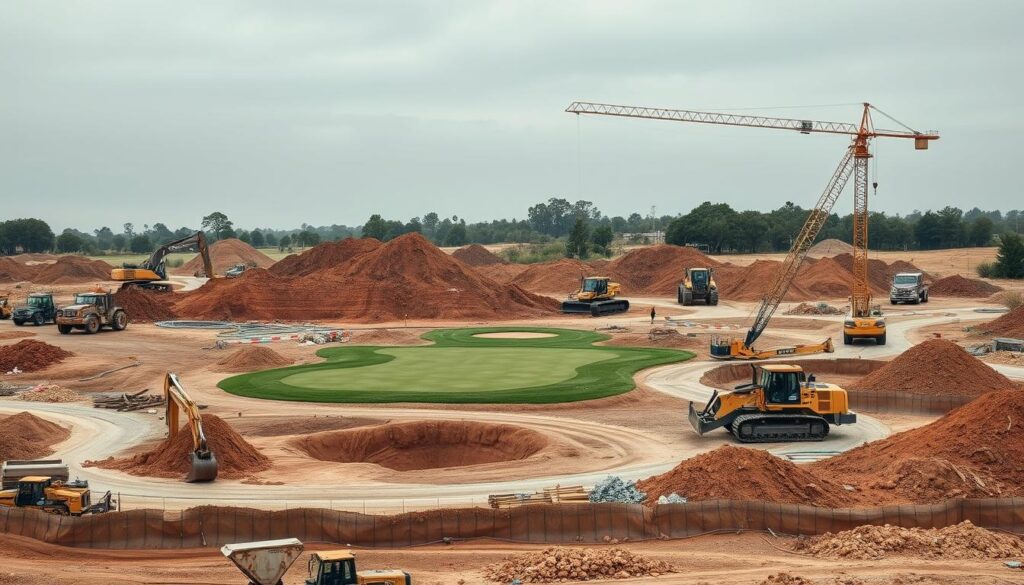
Constructing a golf course demands substantial financial outlays. The expense can fluctuate widely, from $5.55 million to $21 million, influenced by several factors. Typically, the costs for building the course itself account for less than half of the total investment required to launch a new golf facility.
Site Preparation and Earthmoving
Earthmoving costs are a significant component of golf course development. For a standard course, these expenses can exceed $375,000, whereas a high-end course may necessitate up to $750,000. The costs for site preparation and landscaping can span from $500,000 to $2 million. Also if rock blasting is required, it can add $15,000 to $150,000 to the overall budget.
Irrigation and Drainage Systems
The installation of an effective irrigation system is vital for maintaining a golf course. The cost for this on a new course varies between $750,000 and $2 million. For a more basic course, the expenses for irrigation and the pump station start at $130,000, whereas an upscale course may invest up to $910,000.
Greens, Fairways, and Bunkers Construction
The construction of greens and fairways can incur costs between $1 million and $3 million. For a typical course, the cost of building greens is about $190,000, whereas an upscale course may spend as much as $600,000. Bunkers, on the other hand, range from $17,000 for a minimalist course to $84,000 for a high-end one.
| Course Type | Total Construction Cost | Earthmoving Cost | Irrigation Cost |
|---|---|---|---|
| Minimalist | $521,000 | N/A | $130,000 |
| Average | $2,218,000 | $375,000 | $520,000 |
| Upscale | $5,814,000 | $750,000 | $910,000 |
Infrastructure and Facilities

Creating a golf course is more than just laying out fairways and greens. The infrastructure and facilities are vital for the overall experience and functionality. Let’s look at the important components that affect the total cost of golf course development.
Clubhouse and Amenities
Golf course clubhouse construction is a major expense. A basic 15,000 square foot clubhouse might cost about $3 million. However, larger, luxurious facilities, covering 35,000 to 40,000 square feet, could range from $6 to $8 million. These buildings often feature pro shops, restaurants, and locker rooms, enhancing the golfer’s experience.
Parking and Access Roads
Parking and access roads are crucial for accessibility. The cost to build these varies greatly, depending on the course’s location and terrain. These costs are part of the off-site construction, separate from the usual golf course budget. Effective parking areas ensure smooth traffic flow and easy access for golfers.
Maintenance Facilities and Equipment
Maintenance equipment costs are a recurring expense for golf course owners. These facilities house the machinery essential for maintaining the course’s quality. The expense depends on the course’s size and the equipment’s quality. Regular upgrades and replacements are vital to keep the course in excellent condition over time.
When planning your golf course development, remember that infrastructure and facilities typically make up 15% to 20% of the total construction budget. Proper planning and budgeting for these elements are critical to creating a successful and sustainable golf course.
Landscaping and Aesthetics
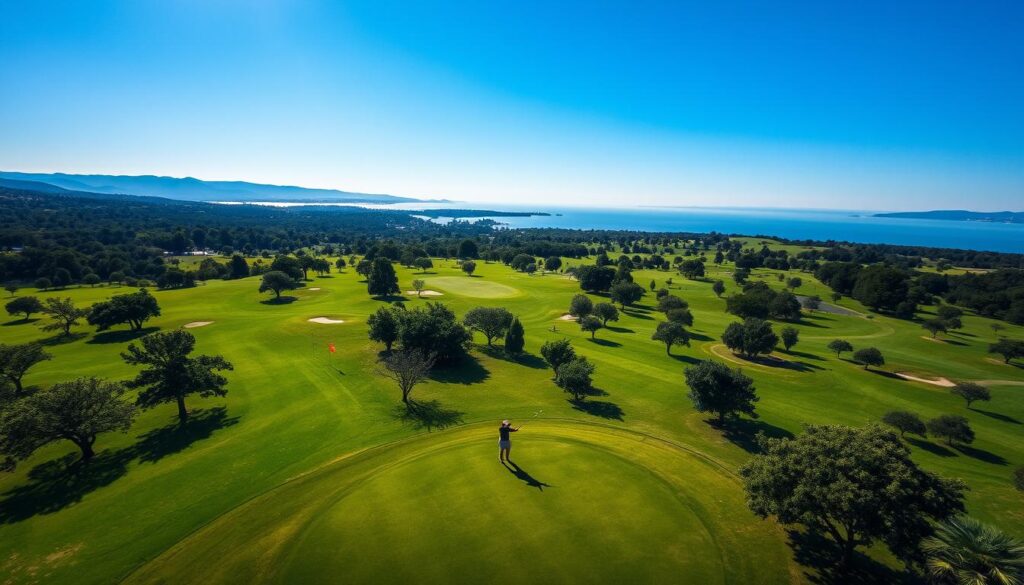
Creating a visually stunning golf course extends beyond just planting grass. The costs for golf course landscaping vary widely, depending on the design and features you select. Your turfgrass expenses will be a significant part of the budget, as choosing the right grass type is vital for playability and upkeep.
Planting and Turfgrass Selection
When selecting turfgrass, consider climate, soil type, and expected foot traffic. Popular choices include Bentgrass for greens and Bermuda grass for fairways. These selections affect long-term maintenance costs, so choose wisely.
Water Features and Landscaping Elements
Water feature installation can significantly enhance your course’s aesthetic appeal. From serene ponds to dramatic waterfalls, these elements add beauty and challenge to play. However, they require ongoing maintenance, which can increase your landscaping budget.
Ongoing Maintenance Considerations
Maintenance is crucial for golf courses. Regular mowing, fertilizing, and pest control are vital to maintain your course’s quality. Investing in high-quality maintenance practices for greens ensures a smooth and consistent surface for putting, improving the overall golf experience.
| Landscape Element | Initial Cost Range | Annual Maintenance Cost |
|---|---|---|
| Turfgrass (per acre) | $3,000 – $8,000 | $1,500 – $4,000 |
| Water Feature Installation | $5,000 – $50,000+ | $1,000 – $5,000 |
| Tree Planting (per tree) | $200 – $1,000 | $50 – $200 |
By planning your landscaping and considering long-term maintenance, you can create a beautiful and sustainable golf course. Players will love it for years to come.
Types of Golf Courses and Their Costs

Golf courses come in various forms, each with distinct features and financial implications. From the classic 18-hole layouts to the more compact par-3 courses, the options for players and investors are numerous. It’s essential to understand these differences when evaluating the costs of building a golf course.
Traditional 18-hole courses are still favored but come with a hefty price tag for construction and upkeep. Par 5 holes, especially, are land and resource-intensive. On the other hand, shorter courses are on the rise. In Florida, for instance, about 19% of the over 1,260 courses are compact, highlighting a shift in golf facility development.
Compact courses have several benefits. They need less land, which lowers the upfront costs and maintenance expenses. These layouts are ideal for beginners and those with limited time, offering a quicker game. A blend of par 3 and par 4 holes can make for a challenging yet efficient course.
| Course Type | Average Construction Cost | Typical Green Fees |
|---|---|---|
| Traditional 18-hole | $3-5 million | $50-$150 |
| 9-hole | $1.5-2.5 million | $25-$75 |
| Executive (Par 3) | $750,000-1.5 million | $15-$40 |
When evaluating golf course types, consider both the initial investment and long-term sustainability. High-end courses can generate significant revenue but are often less accessible. More budget-friendly options, however, may draw a wider audience. The optimal choice hinges on your target market, land availability, and financial constraints.
Public vs. Private Golf Courses
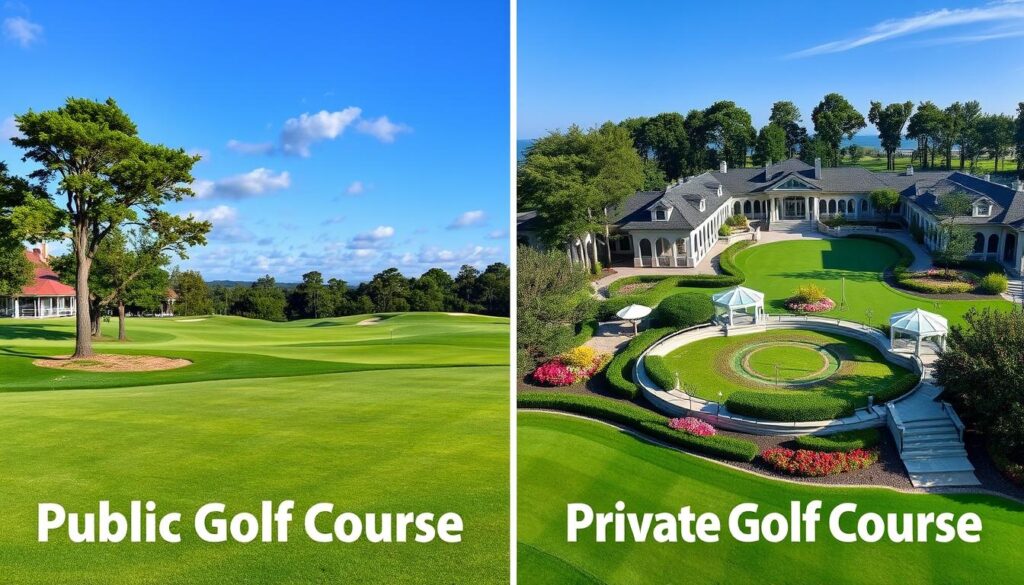
Golf courses are divided into public and private categories, each with distinct financial structures and revenue streams. This section looks at the cost differences and revenue models of public and private golf courses.
Cost Differences
Public golf courses generally have lower upfront construction costs. They focus on accessibility, offering basic amenities. In contrast, private clubs invest in luxury amenities and unique designs, increasing their initial costs.
Constructing an 18-hole public course can range from $3 million to $10 million. Conversely, a premium private club might exceed $30 million. For instance, the Bulle Rock Golf Club, a renowned public course in Maryland, is appraised at $4.75 million. Meanwhile, the PGA National Resort & Spa, a private club, is valued at over $80 million.
Revenue Models
Public and private courses employ different revenue strategies. Public courses mainly generate income from green fees, cart rentals, and pro shop sales. They must draw a consistent number of golfers to be financially viable. Pricing varies by day of the week and season.
| Course Type | Weekday Rate | Weekend Rate | Twilight Rate |
|---|---|---|---|
| Public Municipal | $30-$50 | $40-$70 | $25-$35 |
| Public Resort | $75-$150 | $100-$200 | $50-$100 |
| Private Club | Annual Membership: $5,000-$100,000+ | ||
Private clubs earn through membership fees, which can be from $5,000 to over $100,000 annually. They also benefit from guest fees, food and beverage sales, and event rentals. This approach ensures a steady income, supporting higher maintenance and exclusive amenities.
The emergence of 9-hole courses has introduced a new economic perspective to golf. These shorter layouts, such as some of the best 9-hole courses in the United States, offer an affordable and efficient alternative for players and course owners alike.
9-Hole vs. 18-Hole Courses

Deciding between a 9-hole or 18-hole golf course layout is a critical step in planning. This decision significantly influences both the upfront costs and ongoing expenses. The size of the golf course is an important factor in this decision-making process.
Cost Implications of Course Size
Generally, 9-hole golf courses are less expensive to build than 18-hole courses. The cost per hole can vary from $50,000 to $175,000 for high-end courses. A 9-hole course typically occupies about half the land of an 18-hole course, thus reducing costs associated with land acquisition and upkeep.
Land and Resource Requirements
An 18-hole course with a par of 72 generally requires 140 to 180 acres. In contrast, a 9-hole course with a par of 35 or 36 needs roughly half that land. This disparity in land usage directly impacts the costs of irrigation, landscaping, and maintenance for an 18-hole course.
| Course Type | Land Required (Acres) | Approximate Cost per Hole |
|---|---|---|
| 9-Hole Course | 70-90 | $50,000-$175,000 |
| 18-Hole Course | 140-180 | $50,000-$175,000 |
| Executive Course (18-Hole) | 100 | Varies |
| Par 3 Course (18-Hole) | 65 | Varies |
While 18-hole courses provide a comprehensive golfing experience, 9-hole layouts can be more budget-friendly and ideal for specific markets or land limitations. The choice between the two hinges on factors such as budget constraints, target audience, and local golf demand.
Specialty Courses (e.g., Par 3, Executive)
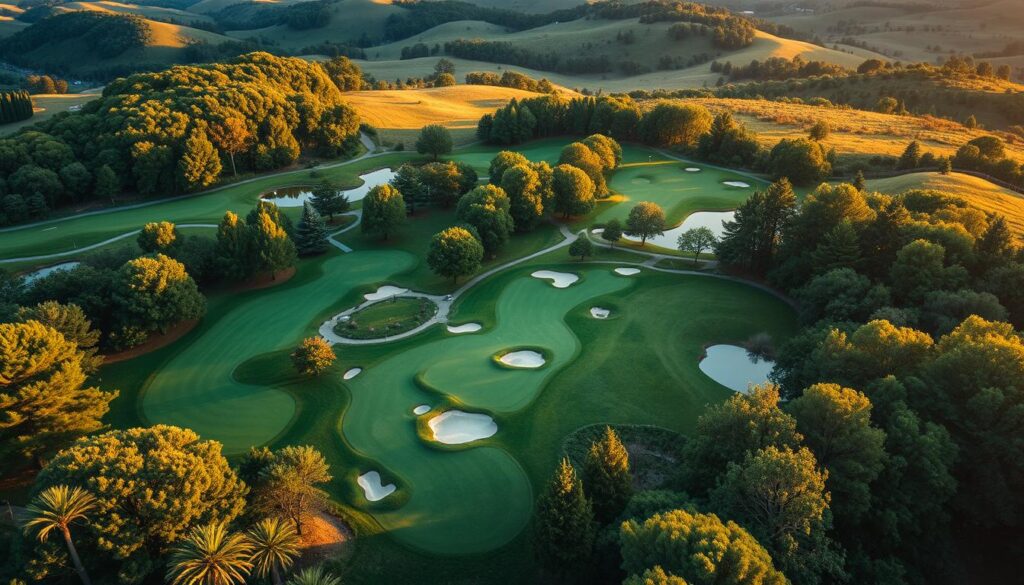
Golf enthusiasts seeking unique experiences can look at specialty courses such as Par 3 and executive layouts. These compact designs bring distinct advantages in terms of costs and construction. They are designed to be more affordable and efficient.
Unique Design Considerations
Par 3 courses feature 9 or 18 holes, each ranging from 100 to 250 yards. Executive courses are slightly longer, typically under 5,200 yards for 18 holes. These courses focus on shorter shots and quicker play. They are perfect for beginners or those with limited time.
Cost Benefits and Target Audience
Specialty golf facilities come with lower expenses compared to traditional courses. They require less land and have reduced maintenance costs. These courses appeal to various groups, including new golfers, seniors, and busy professionals looking for a quick game.
| Course Type | Length (18 holes) | Par | Target Audience |
|---|---|---|---|
| Par 3 | 1,800-4,500 yards | 54-58 | Beginners, Seniors |
| Executive | 3,500-5,200 yards | 55-65 | Time-constrained Players |
| Regulation | 5,200+ yards | 66-73 | All Skill Levels |
Innovative concepts like PowerPlay Golf with dual flags on greens and FootGolf courses add variety to the golfing landscape. These designs highlight how specialty courses can offer unique experiences while keeping construction and maintenance costs manageable.
Financing and Budgeting for a Golf Course
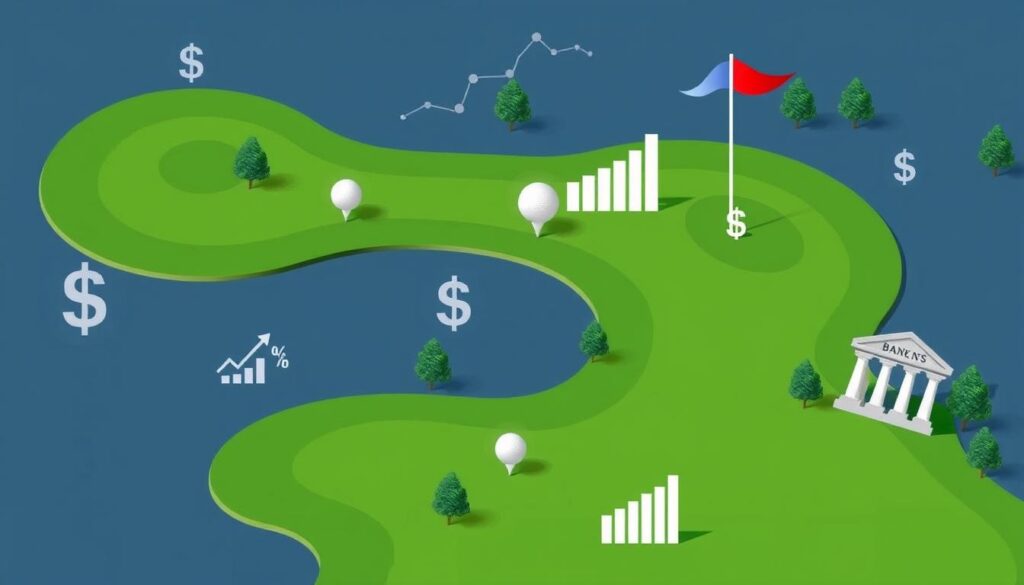
When planning your golf course financing, it’s essential to approach it with precision. Golf development budget planning is vital for success. The average annual maintenance for a U.S. golf course exceeds $810,000, with private courses reaching over $1 million. Labor costs, the biggest expense at 56.74%, average more than $463,000 annually.
Exploring course construction funding reveals that costs differ by layout and conditioning. Operating budgets cover essential maintenance like labor and fertilizers. Capital budgets, on the other hand, focus on asset acquisition. Offering tiered memberships can increase revenue by attracting a broader customer base.
Pro shops enhance sales through branded merchandise, and targeting the wedding industry can add to your income. Investing in quality equipment like rangefinders improves the player experience and can justify higher fees.
| Expense Category | Percentage of Total Expenses |
|---|---|
| Labor | 56.74% |
| Fertilizer | 5.05% |
| Equipment Lease | 5.01% |
| Repair Maintenance | 4.56% |
| Fungicides | 4.28% |
Effective golf course financing combines equity and debt. Detailed budget presentations, including historical data, help justify expenses to owners. Planning, projecting, and controlling are crucial for successful golf development budget planning.
Funding Sources
Building a golf course demands a significant financial investment. It’s essential to understand the various funding sources to successfully navigate the complex world of golf course development. Let’s look at the primary options available to those looking to develop a golf course.
Private Investors and Partnerships
Many golf courses are funded through personal savings and partnerships. Over the last two decades, over 1,000 entrepreneurs have crafted business plans for starting and expanding golf courses. Wealthy individuals or groups often view golf courses as lucrative investments, offering both financial gains and social status.
Loans and Financial Institutions
Golf development loans from banks are a leading funding source. Banks demand detailed business plans to bolster confidence in repayment. Your plan must encapsulate an industry analysis, detailing market size, competitor analysis, and growth projections. It’s vital to pinpoint your target market segments, such as families, retirees, and dedicated golfers.
Government Grants and Incentives
Government incentives for golf courses can offer supplementary financial backing. Certain regions provide grants or tax breaks for golf course development, especially if it boosts local economic growth or tourism. It’s crucial to investigate local and state programs that could benefit your project.
| Funding Source | Advantages | Considerations |
|---|---|---|
| Bank Funding | Common method for capital projects | Requires strong business plan |
| Member Bonds | “Friendly debt” with lower interest rates | Provides more flexibility |
| Reserves/Initiation Fees | No repayment concerns | Limited by available funds |
| Angel Funds | No repayment obligations | Relies on member donations |
Keep in mind, venture capitalists rarely fund individual golf courses unless they have a national footprint. It’s crucial to evaluate these funding options meticulously to discover the optimal match for your golf course venture.
Budget Management
Smart golf course budget management is crucial for a project’s success. We’ll look at construction cost estimation and financial planning for golf facilities in detail.
Cost Estimation and Financial Planning
When planning your golf course, consider various expenses. The average annual maintenance for an 18-hole course in the U.S. varies from $294,456 for daily fee courses to $630,104 for private clubs. Labor accounts for 56.74% of the budget.
Water costs differ by region, with a national average of $107,000 annually. Southwest courses face higher bills, averaging $238,000 yearly. Equipment is another significant expense. New private clubs often spend $2 million or more on machinery.
Contingency Planning for Unexpected Expenses
It’s smart to budget for surprises. Course accessories, for instance, can cost about $4,000 annually. Design fees for architects are 8-12% of construction costs for an 18-hole course. Travel expenses for architects are billed separately.
| Expense Category | Percentage of Budget |
|---|---|
| Labor | 56.74% |
| Fertilizer | 5.05% |
| Equipment Lease | 5.01% |
| Equipment Repair | 4.56% |
| Fungicides | 4.28% |
| Fuel and Lubricants | 2.65% |
By planning ahead and allocating funds wisely, you’ll be better prepared to manage the financial aspects of your golf course project.
Case Studies: Examples of Golf Course Construction Costs

Golf course construction case studies provide deep insights into the financial aspects of building these facilities. They showcase the diverse costs involved in golf development projects. By examining specific projects, we can understand the financial scales these ventures encompass.
Notable Golf Course Projects and Budgets
Golf course budgets vary significantly, from simple municipal layouts to elaborate luxury resorts. Each project encounters distinct financial hurdles and challenges. A recent analysis of three golf courses in Knoxville reveals the typical expenses:
| Golf Course | Annual Capital Needs |
|---|---|
| Knoxville Municipal | $41,000 |
| Whittle Springs | $43,000 |
| Williams Creek | $46,000 |
These figures underscore the continuous financial commitments required to sustain golf courses. When contemplating a new course, it’s essential to account for both the upfront construction and ongoing maintenance expenses.
Lessons from Past Projects
Effective golf course development hinges on meticulous planning. Financial feasibility studies are crucial for determining costs and assessing market demand. Technical evaluations, meanwhile, assess the site’s suitability, including earthwork and irrigation requirements. Proper planning can prevent costly mistakes, just as correct swing techniques enhance your golfing performance.
Sustainability is paramount in contemporary golf course design. Environmental impact assessments ensure compliance with regulatory standards and community expectations. Consulting with specialists like golf architects and agronomists facilitates more efficient, cost-effective designs. These designs must harmonize playability with environmental responsibility.
Environmental and Regulatory Considerations
Creating a golf course is more than just designing a beautiful landscape. It involves understanding the environmental impact and adhering to regulations. You must navigate a complex set of requirements to ensure your course is eco-friendly and legally compliant.
Navigating Environmental Impact Assessments
Environmental impact assessments are crucial in golf course development. They assess potential effects on ecosystems and water resources. Since 1992, the golf industry has made substantial progress in environmental design. The American Society of Golf Course Architects has led the way, publishing guidelines on environmentally responsible practices.
Golf courses can serve as protective buffers for sensitive areas, improving water quality and wildlife habitats. This approach highlights the potential for golf to coexist with nature harmoniously.
Compliance with Local and Federal Regulations
Regulatory compliance for golf facilities is intricate and location-specific. For example, New York State mandates licensed designers for site analysis and permits for water withdrawal and stormwater management. The Clean Water Act also regulates activities impacting wetlands, necessitating specific permits. Consulting local authorities and environmental agencies is crucial to ensure compliance with golf course environmental regulations.
The golf industry has made significant strides in reducing environmental impact. By 2015, about 26% of U.S. golf facility acreage was dedicated to natural features. This shift towards sustainability underscores the importance of balancing golf with environmental stewardship. By focusing on these aspects, you’re not just constructing a golf course; you’re creating a sustainable ecosystem that benefits both the game and the environment.




